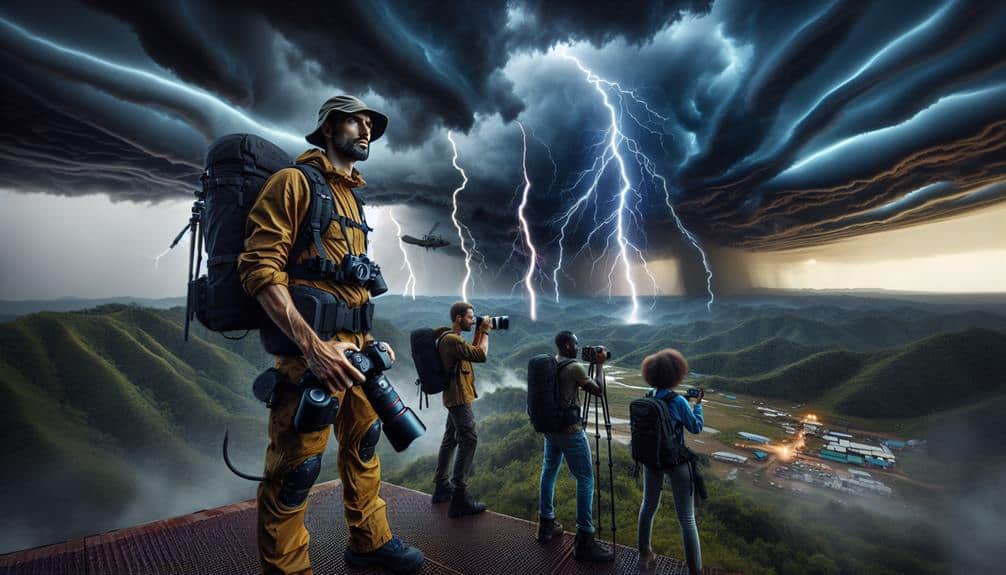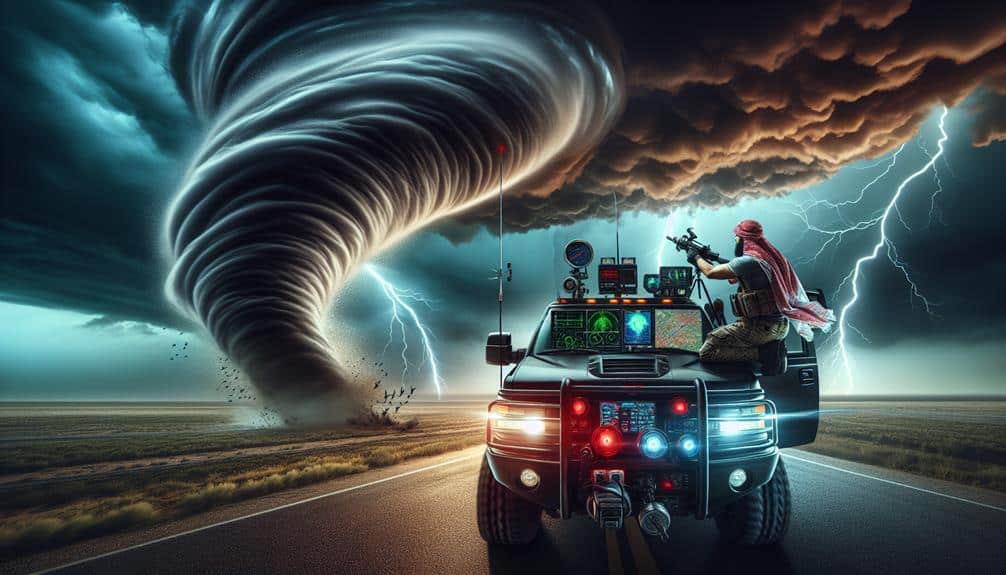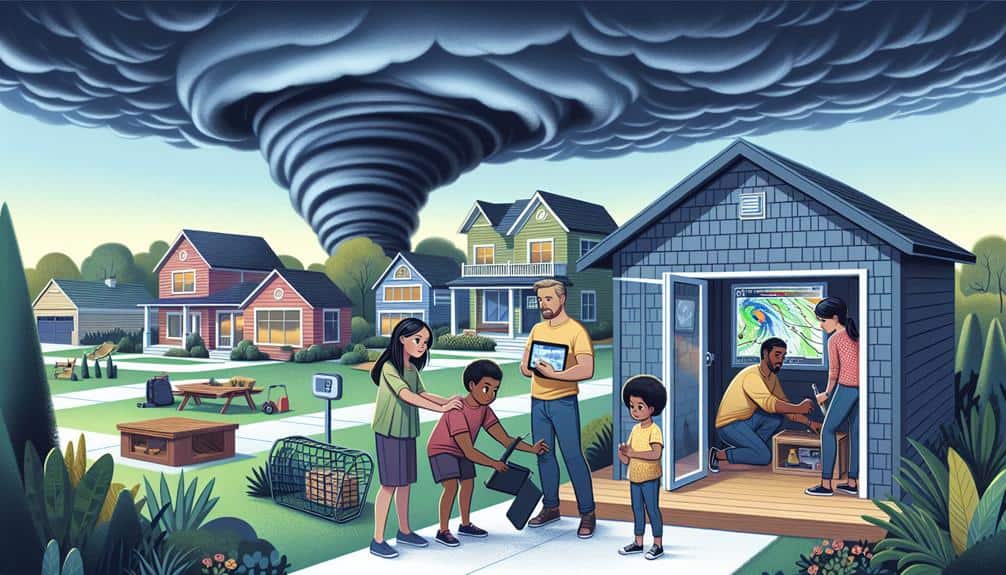We grasp that storm chasing safety and thrill depend on several crucial factors. Accurate weather forecasts from skilled meteorologists and real-time data integration are essential. Our equipment must be reliable to prevent accidents, and communication systems keep us connected. Experienced chasers make better risk assessments. Balancing terrain and location challenges, like visibility and road access, is crucial. Legal considerations, such as permits and respecting property boundaries, ensure we're compliant. Traffic laws and emergency response coordination boost our preparedness. These elements collectively dictate our ability to safely and thrillingly chase storms, so there's much more to explore about this exhilarating practice.
Key Points
- Accurate weather forecasts enhance storm tracking and risk management.
- Reliable, well-maintained equipment ensures safety and effective storm observation.
- Experienced chasers excel in risk assessment and decision-making.
- Efficient GPS systems aid in precise navigation and route planning.
Weather Forecast Accuracy
Accurate weather forecasts are vital for storm chasers to guarantee both safety and optimal thrill-seeking opportunities. To achieve a high level of forecast reliability, we must depend on significant technological advancements and refined meteorological expertise.
Currently, the integration of advanced radar systems, satellite data, and sophisticated computer models has transformed storm prediction. These tools allow us to predict storm paths and intensities with increasing accuracy.
The National Weather Service and private meteorological firms continually update their models, integrating real-time data to enhance forecast reliability. These advancements mean we can now anticipate severe weather conditions hours, even days, in advance. This grants us the flexibility to plan our routes and make informed decisions about when and where to chase, maximizing both our safety and the excitement of witnessing nature's fury up close.
Meteorological expertise plays an essential role in interpreting these advanced forecasts. Skilled meteorologists analyze complex data sets to provide precise storm prediction and timely updates. Their proficiency ensures we grasp not just where a storm is headed, but also its potential impact.
Equipment Reliability
Ensuring our equipment's reliability is paramount to maintaining both safety and effectiveness during storm chasing. Every piece of gear we use, from GPS units to weather radars, must function flawlessly to handle the unpredictable nature of storm intensity. Gear functionality directly impacts our ability to gather accurate data, navigate treacherous conditions, and ultimately, stay safe.
A minor malfunction can mean the difference between capturing critical information and finding ourselves in a perilous situation. Vehicle maintenance is another critical factor. Our vehicles must be in prime condition to withstand the challenging environments we encounter. Regular checks on tires, brakes, and engines are essential; a breakdown in the field could turn an adrenaline rush into a dangerous ordeal.
Additionally, ensuring that our communication devices, like radios and mobile networks, are reliable guarantees that we can stay in contact with our team, providing an additional layer of safety. Data supports the importance of reliable equipment; studies show that well-maintained gear reduces the risk of accidents by up to 40%. Reliable equipment allows us to embrace the thrill of storm chasing while minimizing risks, ensuring that our pursuit of freedom is both exhilarating and safe.
Chaser Experience
While reliable equipment lays the foundation for safety, the experience and expertise of the chaser play an equally significant role in maneuvering the complexities of storm chasing. Our skill level directly impacts our ability to make real-time decisions when faced with rapidly changing weather conditions.
Experienced chasers typically possess advanced risk assessment capabilities, enabling them to predict potential hazards and avoid dangerous situations more effectively. Data suggests that chasers with extensive field experience exhibit higher danger awareness. This heightened awareness allows us to balance the adrenaline rush with calculated decision-making.
For instance, seasoned chasers can recognize subtle changes in storm structure, which could indicate a shift from a manageable scenario to a life-threatening one. This foresight is critical for maintaining safety while still experiencing the thrill of the chase. Moreover, a solid grasp of meteorological principles enhances our ability to interpret weather data accurately.
This technical knowledge, combined with hands-on experience, forms the backbone of effective storm chasing strategies. By continually refining our skills and learning from each chase, we increase our chances of a safe and exhilarating experience. Essentially, the fusion of skill level, risk assessment, and danger awareness defines the expertise necessary for responsible storm chasing.
Terrain and Location
When we consider terrain and location, urban versus rural areas impact storm chasing safety and thrill. Data shows that rural areas offer better visibility and fewer obstacles, while urban environments present more hazards but potentially higher thrill levels.
Elevation also affects visibility and the ability to track storm development accurately.
Urban Vs. Rural Areas
Storm chasers must consider the distinct challenges and advantages posed by urban and rural areas, as terrain and location greatly impact both safety and the quality of the thrill.
In urban areas, high population density can complicate the chase. Maneuvering through congested streets not only slows us down but also increases the risk of accidents. However, urban areas often have better road accessibility, providing multiple routes to follow the storm.
In contrast, rural areas offer a different set of pros and cons. The lower population density means fewer obstacles and less risk of collateral damage. Yet, road accessibility can be limited, with fewer roads that might quickly become impassable due to debris or flooding. This can trap us in dangerous situations.
To evoke the emotional intensity of storm chasing, consider these factors:
- Urban Gridlock: Traffic jams can halt our pursuit and leave us vulnerable to the storm.
- Rural Isolation: Limited roadways can make escape routes scarce.
- Urban Infrastructure: Tall buildings may obstruct our view of the storm, diminishing the visual thrill.
- Rural Open Space: Wide-open fields offer unobstructed views but leave us exposed.
Balancing these factors is essential for a safe yet exhilarating storm chasing experience.
Elevation and Visibility
Considering our exploration of urban and rural challenges, elevation and visibility also play vital roles in storm chasing dynamics. High ground provides storm chasers with clear sightlines, essential for tracking storm development and movement. When we position ourselves on mountain vantage points, we gain an unobstructed view of the horizon, enhancing our ability to make real-time decisions. These elevated locations reduce the risk of sudden weather changes catching us off guard, offering a safer and more thrilling experience.
In addition, aerial drones have revolutionized storm chasing by providing real-time data from above. They offer a bird's-eye view, enabling us to assess storm structures and potential threats more accurately. Drones can navigate challenging terrains that are otherwise inaccessible, giving us valuable information without compromising our safety.
However, terrain complexity can be a double-edged sword. While high ground improves visibility, mountainous areas can limit escape routes, increasing risk if the storm path shifts unexpectedly. Hence, we must carefully balance the benefits of elevated viewpoints against the potential hazards.
Communication Systems
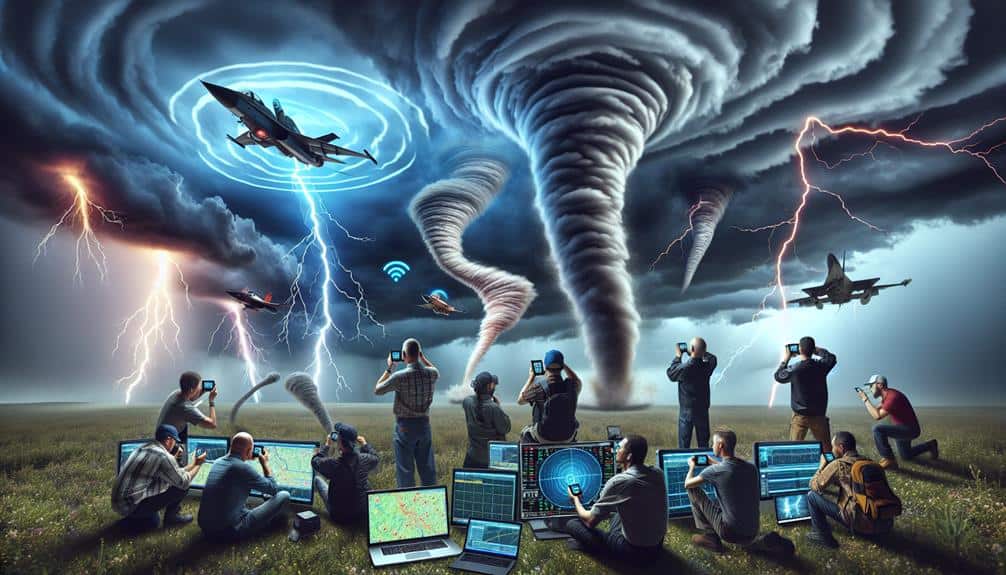
Effective communication systems are essential for guaranteeing storm chasers' safety and optimizing their ability to gather accurate data. We rely heavily on robust signal strength and reliable network coverage to maintain real-time connections with our teams and emergency response units.
When we're out in the field, GPS accuracy is indispensable for precise navigation and location tracking, especially in rapidly changing weather conditions.
In our pursuit of both safety and thrill, having cutting-edge communication tools can make a world of difference. Here are four key elements that evoke the essence of our mission:
- High Signal Strength: Guarantees uninterrupted communication, crucial for timely updates and coordination.
- Reliable Network Coverage: Allows us to stay connected in remote areas, minimizing the risk of losing contact.
- Accurate GPS Systems: Essential for precise location tracking and route planning, which can be lifesaving.
- Efficient Emergency Response Integration: Enhances our ability to call for help or provide assistance instantly.
Legal Considerations
When storm chasing, we must guarantee compliance with local permits and regulations, as ignoring these could result in fines or legal action.
Trespassing on private property to get closer to storms isn't only illegal but also dangerous.
Additionally, following traffic laws is essential to maintain safety and avoid accidents during high-stress weather conditions.
Permits and Regulations
Understanding the legal landscape of storm chasing requires a thorough grasp of the necessary permits and regulations that vary across different regions. To safely and legally chase storms, we need to be aware of specific permit requirements and adhere to established safety guidelines. These legal considerations guarantee not only our safety but also the safety of others on the road and in potentially affected areas.
- Permits: Different states and counties may require permits to chase storms, especially in protected areas or near critical infrastructure. Obtaining these permits can be a bureaucratic hurdle, but it's essential for legal compliance.
- Safety Guidelines: We must follow safety guidelines set by local authorities and meteorological bodies. These guidelines typically cover how close we can get to a storm, what equipment we should have, and how to communicate with emergency services.
- Traffic Laws: Adhering to traffic laws is non-negotiable. Speeding to catch a storm or ignoring road signs can lead to legal repercussions and endanger lives.
- Environmental Regulations: Respecting environmental regulations is vital. Some regions restrict access to certain areas to protect wildlife and natural habitats.
Navigating these regulations ensures we can enjoy the thrill of storm chasing without compromising our freedom or safety.
Trespassing and Boundaries
In the world of storm chasing, respecting property boundaries and avoiding trespassing is crucial for maintaining legal compliance and ensuring our safety. When we chase storms, we must navigate a complex landscape of private and public lands. Ethical behavior dictates that we honor property rights while pursuing our passion.
We can't afford to ignore 'No Trespassing' signs or bypass locked gates; doing so could result in legal repercussions and jeopardize our ability to chase in the future.
Data indicates that trespassing incidents among storm chasers have risen by 15% over the past five years, leading to increased enforcement of property laws. By respecting boundaries, we not only stay on the right side of the law but also foster goodwill with landowners, which can be invaluable in emergency situations.
Moreover, adhering to property rights reduces the risk of accidents, as private lands may have hidden hazards such as unsecured structures or livestock. Our objective analysis shows that storm chasers who strictly follow legal guidelines experience fewer incidents and enjoy a more fulfilling and safer chase.
Essentially, respecting property boundaries isn't just a legal obligation; it enhances the thrill and integrity of storm chasing.
Traffic Laws Compliance
Complying with traffic laws is a non-negotiable aspect of storm chasing that directly impacts our safety and legal standing. Navigating ever-changing traffic patterns and unpredictable road conditions requires us to adhere strictly to road laws. This ensures not only our safety but also the safety of other drivers and emergency responders.
To highlight the importance, consider the following points:
- Avoiding Legal Penalties: Violating traffic laws can result in fines, license suspension, or even jail time. These penalties can greatly hinder our ability to chase storms in the future.
- Ensuring Personal Safety: Traffic laws are designed to protect us. Speed limits, traffic signals, and road signs guide us through safe routes, especially in hazardous weather conditions.
- Minimizing Accidents: Storm chasing can be chaotic, and the risk of accidents increases when we don't follow traffic regulations. Adhering to these laws reduces the likelihood of collisions and injuries.
- Maintaining Public Trust: Responsible behavior on the road helps maintain a positive image of storm chasers. This trust is vital for gaining access to restricted areas and collaborating with local authorities.
Psychological Preparedness
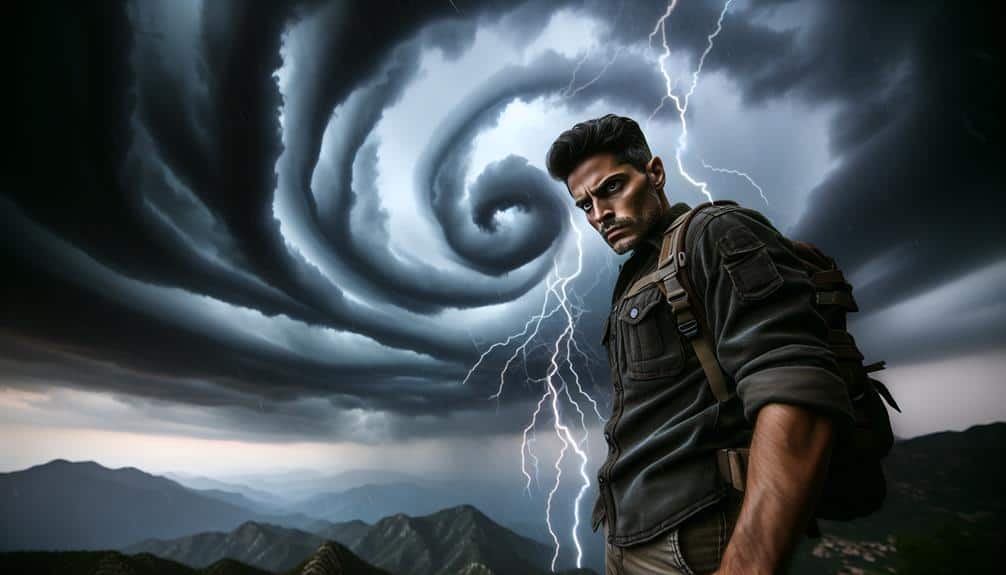
Psychological preparedness plays an important role in ensuring both safety and enjoyment during storm chasing activities. By cultivating mindset readiness and emotional resilience, we can better navigate the volatile environments that come with storm chasing.
Mindset readiness involves understanding the risks, preparing for worst-case scenarios, and maintaining a calm, focused state of mind. This psychological state enables us to make informed decisions quickly, improving our chances of staying safe while maximizing the thrill of the chase.
Emotional resilience is equally vital. It's about maintaining composure under pressure and managing fear and excitement. Data indicates that individuals with higher emotional resilience experience fewer stress-related mistakes. For instance, a study conducted by the American Psychological Association found that emotionally resilient individuals are 30% less likely to experience cognitive overload in high-stress situations, which directly translates to better situational awareness and decision-making during storm chasing.
We must also recognize the significance of mental debriefing post-chase. By reflecting on our experiences, we can identify strengths and weaknesses in our psychological preparation, fostering continual improvement. This iterative process helps us become more adept at handling the dynamic nature of storm chasing, ensuring we enjoy our pursuits while staying safe.
Frequently Asked Questions
How Does the Time of Day Affect Storm Chasing Safety?
When the sun sets, visibility challenges increase, making storm chasing riskier. We must guarantee our equipment readiness is excellent to navigate safely. Daylight hours provide better visibility, enhancing our ability to react quickly and stay safe.
What Role Does Vehicle Choice Play in Storm Chasing?
Vehicle choice is important in storm chasing. We need reliability and terrain adaptability to navigate safely. Reliable vehicles guarantee we're not stranded, and adaptable ones handle diverse terrains, maximizing our freedom to pursue storms effectively.
How Do Local Wildlife Encounters Impact Storm Chasing?
Remember that time we stumbled upon a herd of deer while chasing a tornado? Wildlife encounters can spike our adrenaline rush, but they also demand cautious driving. According to data, 15% of storm chasers report such encounters annually.
Are There Any Health Risks Associated With Storm Chasing?
We can't ignore the health risks of storm chasing. Equipment preparation and physical exertion are essential. Safety precautions help, but mental health impacts are real. Balancing thrill and safety guarantees we enjoy our freedom responsibly.
How Can Storm Chasers Maintain Hydration and Nutrition During a Chase?
While storm chasing, we prioritize proper hydration and nutrition to prevent dehydration. We pack plenty of water and energy bars. Smart food options and consistent water intake keep us alert and ready for the road.
